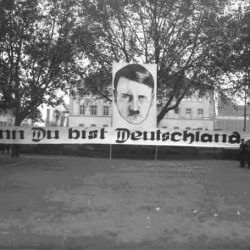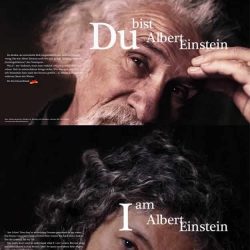A photograph sealed under plexiglass and mounted (MDF), height 96 cm x width 64 cm (edition of 7)
(Edition of 7: height 48 cm x width 32 cm))
Insurance value 2,000 Euro
Concept Tanya Ury
Camera David Janecek
Digital image processing Claudia Stasch
Double Portraits — a collection of works:
- Hermes Insensed 2000 – 2001
- Franco and Elke J. 2002
- lesser is me more or less 2003
- Your Rules 2004
- or else 2007
- Du bist Einstein 2007
- doo bee doo 2007
- Artistic freedom 2013
The artwork doo bee doo features a photographic image of the artist Tanya Ury placed under the picture of an Albert Einstein double (who doesn’t much resemble Einstein) from the German media campaign “Du bist Deutschland” (You are Germany) of 2005. Ury mimics the Einstein pose of the poster, by leaning a furrowed brow onto her left hand. Her image also copies that of the poster in that it is cut off at the lower half of the mouth.
more
“Du bist Deutschland” was an initiative of “Partners for Innovation” coördinated by the Bertelsmann AG and involved 25 media companies. The campaign ran from the end of September 2005 till January 2006. With its TV spots, posters and a budget of ca 30 million Euros, its aim was to inspire positive feelings about the country, principally for the general election of 2nd October 2005.
2005 was also celebrated in Germany as Einstein Year, the 50ieth anniversary of the death of the Nobel Prize winner (1879−1955). For this occasion, the Berlin Town Hall was decorated with an Einstein quote from a letter of 1920 that commemorated the erstwhile famous citizen of the city:
“Berlin is the place, where, because of personal and academic friendships, I felt most at home…”
In 1933 Einstein, who was Jewish, had to flee Germany to the USA.
‘Even after 1945 Albert Einstein didn’t want to have anything to do with the land of his origin. He never saw Germany or Berlin again. His abhorrence of everything German that developed into an irreconcilable hate (The Private Lives of Albert Einstein, Roger Highfield and Paul Carter, 1994) remained unaltered till his death: “He made it clear that he didn’t want to have anything to do with the country of his birth, the inhabi tants of which, he didn’t distinguish as being less guilty of the massacre of the Jews than Hitler. The intellectuals behaved as badly as the mass, with the exception of only a handful of his closest colleagues, he said. He was convinced that the Germans were the cruellest race on earth; according to him they have the mentality of gangsters and have demonstrated no indication of regret for the years of mass murder…”.
Albert Einstein cannot make a stand against the shameful posthumous reinterpretation of his long obsolete letter now cited on the red town hall.’
Dr. Dr. honoris causa Klaus-Heinrich Standke, Berlin-Zehlendorf, Director of Science and Technology at the United Nations ausser Dienst (not currently employed)
www.berlin.de/RBmSKzl/Rathausaktuell/archiv/24139/index.html
(Translation from German Tanya Ury)
***
“In Germany today, this notion of ‘prominent’ Jews has not yet been forgotten. While the veterans and other privileged groups are no longer mentioned, the fate of ‘famous’ Jews is still deplored at the expense of all others. There are more than a few people, especially among the cultural élite, who still publicly regret the fact that Germany sent Einstein packing, without realizing that it was a much greater crime to kill little Hans Cohn from around the corner, even though he was no genius.” Page 84, Eichmann and the Holocaust, extract from Eichmann in Jerusalem, Hannah Arendt 1963, published by Penguin Books, Great Ideas, 2005 (GB)
***
Einstein was born in Ulm, as were Tanya Ury’s Jewish grandparents Sigmar and Hedwig (neé Ullmann) Ury, who fell victim to the Nazis. The second-generation artist Ury, born in London, acquired dual-nationality in 1993, the year when she also moved to live and work in Germany.
Text to the poster: Du bist Albert Einstein (You are Albert Einstein). (Photo: Tobias Gerber, Bilderberg, ©2005) that was widely distributed in Germany 2005:
You are Albert Einstein
You think that your development is slower than everyone else’s? Relatively funny. That’s what Albert Einstein said of himself. The “late developer” was later to win the Nobel Prize.
You really don’t need to understand what E=mc2 means. But one thing you should know is that to underestimate yourself doesn’t bring anything. If you give it all you’ve got, on the other had, you can reach for the stars — in Albert’s case that was quite literally.
You are Germany.
A deutscher Medien (German Media) action under the initiative of “Partners for Innovation.” www.du-bist-deutschland.de
(Translation from German Tanya Ury)
English Text on Tanya Ury’s photographic image:
I am Albert Einstein
Am I slow? Now they’re advertising German patriotism in my name. Not funny. I may have been a Nobel Prize winner but back then I had to flee the country, for my life.
You really don’t need to understand what E=mc2 means. But one thing you should know is your history. Don’t be starry-eyed about false respect and poorly researched spin.
Du bist Deutschland?
doo, bee, doo, bee, doo
***
“Doo bee doo” is the sound made by bored people to fill silence, most often in textual communication, but sometimes verbal. It originates from people whistling or singing a little tune when idle.
Witticism from the 60’s:
To do is to be — Descartes
To be is to do — Sartre
Doo, bee, doo, bee, doo — Sinatra
‘…At the core of the (Du bist Deutschland) campaign was a so-called manifesto, that was also central to the advertisements. The spots that were up to two minutes long, presented chiefly German celebrities at historical scenes in the countryside or city. They illustrated the campaign slogan Du bist Deutschland (You are Germany) in various ways: “You are the Wonder of Germany”, “You are the Tree”, and similarly with sayings and metaphors like, for example, “Your willpower is like fire in the belly” that were to bring about positive feelings, impress and sweep the spectator away.
…Many critics appeared on the scene because the campaign was aimed at individuals as members of a nation-state. They argued that this was a nationalistic position similar to nationalist thinking patterns of National Socialism. As supporting evidence, comparable National Socialist slogans were mentioned:
It is a fact that the National Socialists employed a slogan, directed at Hitler, however: “Denn Du bist Deutschland” (Because, you are Germany) at a rally in 1935 on the Ludwigsplatz in Ludwigshafen. This is illustrated in the book “Ludwigshafen — Ein Jahrhundert in Bildern” (Ludwigshafen — a Hundred Years in Pictures” of the Ludwigshafen on Rhine City Archives, 1999 (ISBN 3−924667−29−2). The sentence is positioned over a large portrait of Hitler. The renowned historians Hans Mommsen and Hans-Ulrich Wehler considered the (Du bist Deutschland) campaign was nevertheless not fraught. The slogan can be found in altered form within the film “Triumph des Willens” (Triumph of the Will) by Leni Reifenstahl, with the words: “Sie sind Deutschland! You (plural) are Germany (as opposed to the singular form of the campaign)”.’ de.wikipedia.org/wiki/…
(Translation from German Tanya Ury)
Presentation
2007 (11.3. – 9.4.) Connected, Group exhibition, opening 12 am, Jewish Cultural Days, Altes Museum im BIS-Zentrum (Old Museum in the BIS Centre), Moenchengladbach (D)
Publications & Press
The Power of Femininity – Hubertus Wunschik has assembled an enormous range of art for a group exhibition of international artists in the Alten Museum (Old Museum). The exhibition “Connected” combines the works of Jewish and non-Jewish provenance.
By Dirk Richerdt – Saturday 10th March 2007 RHEINISCHE POST
“A glance directly inside the entrance to the bourgeois town house falls on the photo montages of Tanya Ury. The 55 year-old Jewish artist, born in London and living in Cologne since 1993, has created a series of dialogic self-portraits: one sees Ury together with antecedents, including the German impressionist painter Lesser Ury and the German Jewish writer Else Sara Ury. And then Albert Einstein turns up. Although she is not related to the scientist, Tanya Ury’s picture of the pipe-smoking researcher together with the artist, holding a (pipe) in the same manner, has a bizarre aura.
A humorous edge flashes up directly with the seriously intended representation of personal history. Tanya Ury’s photos sealed under plexiglass therefore lend the exhibition a certain relief from earnest themes…”
(Translation from German T.U.)
***
2008 (11) doo bee doo discussed in article on Tanya Ury (in German) by Hartmut Bomhoff with image of doo bee doo, Jüdische Zeitung (monthly), Berlin (D) article as PDF

